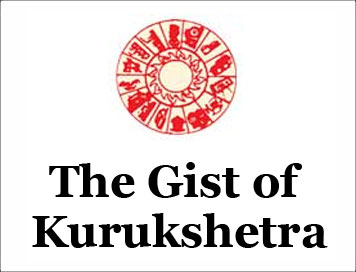(HOT) UPSC Current Affairs 2025 PDF
NEW! The Gist (NOV-2025) | E-BOOKS
(GIST OF KURUKSHETRA) Cooperative and Food Security: A game Changer for India
(GIST OF KURUKSHETRA) Cooperative and Food Security: A game Changer for India
(JUNE-2025)
Cooperative and Food Security: A game Changer for India
Context:
India has 11% (16 crore hectares) of the World’s total Cultivable Area (138 crore hectares) and 18% (140 crore) of the World’s total Population (790 Crore). This indicates that with only 11% of global cultivable land, India has to meet the food requirement of 18% of the World’s Population. The Food and Agriculture Organization (FAO) Statistical Data 2021 shows that India’s total Food Grain Production is 311 million metric tonnes (MMT), while the total storage capacity is only 145 million metric tonnes (MMT). This signifies that there is a shortage of 166 MMT of storage capacity. While countries are self-sufficient, up to 131 percent, with storage structures, India has a shortfall of 47 percent in storage infrastructure.
Potential of the Cooperative Sector
-
In India, there are more than 1.1 lakh PACS with a membership of 3 30 million farmers. Agricultural cooperative, have supported small and marginal farmers through different business models where input services were rendered to ensure enhanced agri productivity.
-
These business models provide services in market access, technology, training, and storage structures in Tamil Nadu, cooperatives run 94 percent of the fair price shops under the public distribution system.
-
Mother Dairy has provided milk and vegetables at fired rates Amu! is one of the successful cooperative settings boosting milk production in India the Academy of Development Studies in Maharashtra lias set up grain banks for the tribal and rural communities. The members can deposit surplus grams and avail themselves of loans in the form of grains.
-
Repaying the loan at the time of the next harvest. The National Agricultural Cooperative Marketing Federation of India Lid- (NAFED) maintains buffer stocks of essential commodities like pulses and onions. Cooperatives can offer a participatory measure for building a centralized procurement and storage system. However, operational and managerial issues limit implementation of procurement and storage systems at PACS level.
PACS & food Security
-
PACS are economically empowered through various programmatic interventions Schemes like Pradhan Mantri Formalisation of Micro food Processing Interposes (PMFMI ) and the Agricultural Infrastructure f und (Ad ) have enabled PACS to engage in activities ensuring rural livelihood and achieving SDG goals.
-
On 31st May 2023, the Ministry of Cooperation, Gol approved the "World’s Largest Grain Storage Plan’ anticipating mobilizing an investment of Rs.1.25 lakh crore. The plan aims to create a storage capacity of 700 lakh tonnes over the next five years.
-
The initiative aims to engage 67,000 functional PACS across India for creating additional food grain storage capacities. One of the primary concerns this project aims to address is inadequate storage capacity that has historically led to significant post-harvest losses. The lack of proper storage facilities results in multiple handling of food grains, reducing the produce’s quality and leading to wastage.
-
Additionally, the high transportation costs incurred due to the lack of nearby storage units further burden the farmers, making it challenging to secure fair prices for their produce. By establishing a robust and decentralized storage network right at the community, this project aims to mitigate capacity challenges and enhance the overall efficiency of the agricultural supply chain.
Governance Mechanism for PACS towards Food Security
- AIF, AMI, PMFME, SMAM, National Cold Chain Development Scheme, National Cooperative Development Corporation, National Bank for Agriculture and Rural Development (NABARD), and Grameen Bhandaran Yojana will act as institutional support to the overall plan for creating foodgrain storage networks in India.
Capacity Building Programs
- There is a need to outline appropriate sensitization and training materials for the members of PACS. Dedicated training and capacity-building programs will help the members of PACS in acquiring the right skills and competencies required for not only setting up storage infrastructure at the local level, but also utilising the space as created for safe storage and disposal of food grains leading to food and nutritional security.
Land Pooling Mechanism
- Land acquisition for godown construction for PACS at the local level can be challenging, especially, in densely populated regions. The timely implementation of foodgrain storage schematic intervention required pooling of small, fragmented lands at the local level in consultation with the Village Panchayats for designing and developing storage infrastructure. This will help meet the rural community’s requirements in densely populated villages/talukas.
Simplified Funding Mechanism
- The absorption capacity of PACS needs to be assessed before funding support is provided to these community level entities. Even though institutional firms have simplified the funding mechanisms to make PACS self-sufficient to set up storage structures through various tools, viz., interest subventions, subsidies, and credit guarantees. PACS need to assess other external and internal risks and uncertainties attached to governance, operation, human resource management, transparency and accountability, etc. to ensure and encourage greater participation from PACS.
Monitoring Dashboards with the Application of Digitalization and Artificial Intelligence
- Computerization of PACS will help in monitoring the key performance indicators displayed on dashboards to enhance performance, transparency and accountability. The application of digitalization and artificial intelligence will allow stakeholders to move towards data-driven governance and the adoption of smart technology and its integration into PACS operation will enhance work efficiency.
Conclusion:
- Looking ahead, the plan aims to expand further by including more PACS under its ambit. Strengthening coordination mechanisms among various stakeholders will be essential to overcome existing challenges. Ensuring the timely resolution of implementation issues, such as land acquisition and fund allocation, will be crucial for the project’s success. With a structured approach and continued government support, the initiative holds the potential to revolutionize grain storage architecture in India, reduce post-harvest losses, and significantly benefit farmers by providing them with improved storage solutions and better price realization for their produce.
CLICK HERE TO DOWNLOAD FULL PDF
CLICK HERE TO DOWNLOAD UPSC E-BOOKS
Study Material for UPSC General Studies Pre Cum Mains
Get The Gist 1 Year Subscription Online
Click Here to Download More Free Sample Material
<<Go Back To Main Page
Courtesy: Kurukshetra



